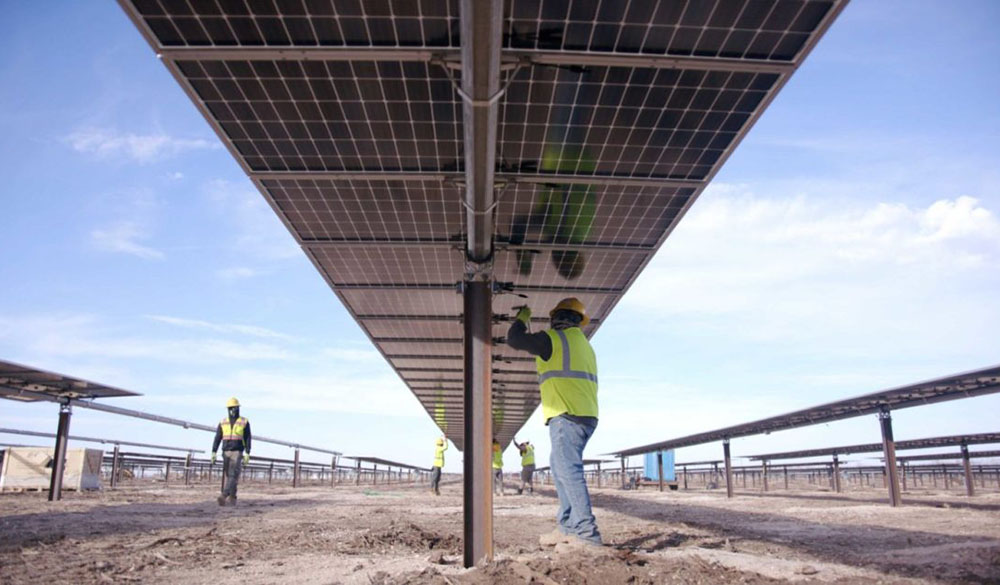
Search...
The U.S. Energy Information Administration’s (EIA) monthly capacity addition update shows that the energy transition is well underway. In the US, the total installed capacity listed as under construction exceeds 25.4 GW. This adds to the existing 107.5 GW of existing solar on the U.S. grid, EIA reported.
Nationwide, small solar projects of 1 MW or less totaled an estimated 39.5 GW, while utility-scale projects above that threshold totaled nearly 68 GW, the EIA reported. As of the latest EIA data release, there are currently 366 utility-scale projects under construction in the United States. The average size of these projects is 69 MW. Of these, 166 projects were 50% or more complete, adding 10.2 GW of capacity.

The largest project under construction is Gemini Solar, developed by Kumbrook infrastructure firm Primerergy. Once complete, the project will add 690 megawatts to the Nevada grid. The next seven largest projects are all located in Texas, with an average capacity of 405 MW.
Texas is the leading state in the construction of utility-scale solar projects, with 28 projects totaling 6.7 GW of installed capacity and an average project size of approximately 240 MW. The largest active project in the state is 500 MW.
Florida has made significant progress in the construction of utility-scale projects. There is currently less than 5 GW of capacity installed in 68 projects with an average size of 73.4 MW. Notably, Florida has a very uniform project design with 65 projects ranging in capacity from 74 MW to 75 MW.
It is followed by California with 3.2 GW of projects under construction, with an emphasis on distributed projects. EIA reported 45 ongoing projects with an average nameplate capacity of 75 MW. The largest active project in the state is 300 MW.
Another 1.96 GW of projects across the country are under full construction pending final approval for commercial operation. There are 48 projects in this category with an average installed capacity of 41 MW. Eight of the projects are 1-megawatt solar facilities in Minnesota, a market known for doing well in community solar projects of this size.
Solar energy is now at the center of plans to decarbonize the U.S. economy, with a high probability of accounting for 70% of planned utility-scale electricity capacity by 2025.
The rise of solar energy as a major source of energy now seems inevitable, but its fate was not always preordained. Less than a decade ago, the technology contributed negligible electricity, and the EIA did not begin reporting annual net PV generation until 2014. That year, solar contributed 27 TWh of electricity to the U.S. grid. Just seven years later, it produced 164 TWh in 2021, a sixfold increase in electricity generation.
This progress has been made possible by supportive industrial policies, economies of scale, increased technological efficiency, and business innovation. The levelized cost of electricity (LCOE) has been falling for years, and as the threat of climate change has grown over the past few years, the benefits of solar and storage have become more apparent.
Looking ahead, project construction is expected to continue to speed up. The Lower Inflation Act of 2022 includes $370 billion for renewable energy and climate measures and calls for a 40% reduction in carbon emissions by 2030. Princeton University, in partnership with Dartmouth College, released the Rapid Energy Policy Evaluation and Analysis Toolkit (REPEAT), Evolved Energy Research and Carbon Impact Consulting, outlining the law's potential impact.
The implications for the U.S. solar industry could be huge, to say the least. Solar deployment could nearly quintuple by 2024 from an annual rate of 10 GW of capacity additions in 2020, adding 49 GW of utility-scale solar per year, the Princeton report said. Solar deployment could exceed 100 gigawatts per year by 2030, said Princeton.
Solar investment could reach $321 billion by 2030, almost double the $177 billion projected under current policies. The IRA would generate nearly $3.5 trillion in cumulative capital investment in new U.S. energy supplies over the next decade, said the report.